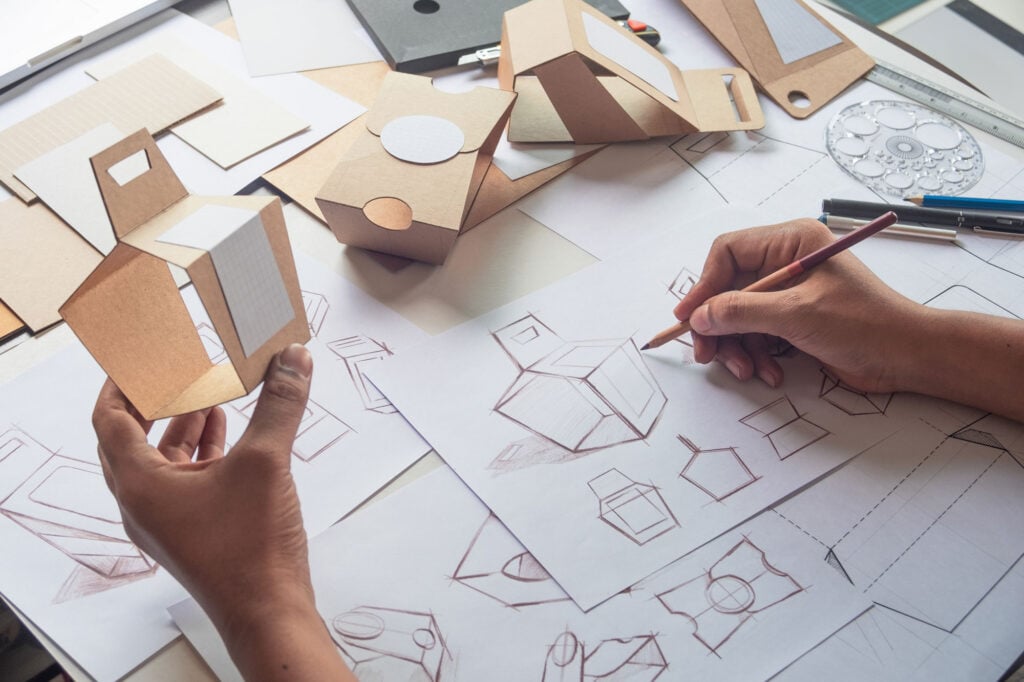The visual appearance of a product is crucial as it not only distinguishes it from competitors but also enhances its market appeal and strengthens brand identity. When a product’s unique design is replicated by others, it can dilute the brand’s distinctiveness, potentially leading to a loss of market share and consumer trust.
This is why obtaining a design patent is vital for protecting the unique look and ornamental visual appearance of your product, ensuring that competitors cannot replicate your design. A design patent protects the shape, surface details, and overall ornamental appearance of your product.
In this guide, we will clearly explain how to secure a design patent, highlight its importance, and guide you through the application process to effectively protect your creative designs and strengthen your brand’s position in the market.
What You’ll Know After Reading This Article
- Gain insights into how a design patent can elevate your product by safeguarding its unique visual appeal, setting it apart in the marketplace.
- Discover the strategic advantages of securing a design patent, including how it can enhance brand identity and provide a competitive edge.
- Understand the process and benefits of obtaining a design patent, empowering you to protect and capitalize on your innovative designs effectively.
What Is A Design Patent? Understanding The Basics
A design patent safeguards the unique visual elements of a product, with protection primarily based on the drawings or illustrations that depict its ornamental appearance. Design patents protect the ornamental appearances of products, distinguishing them from utility patents that focus on functionality. In contrast to utility patents, which protect an invention’s operational features, design patents are exclusively concerned with how a product looks. They offer legal coverage for various aesthetic attributes like the configuration and ornamentation on an article of manufacture.
Design and utility patents differ primarily in their scope of protection. Utility patents pertain to how inventions function—their mechanics and uses—while design patents safeguard against duplication of the visual characteristics such as shape or pattern work associated with an object’s look. The latter pertains strictly to the ornamental aspect rather than any functional element inherent in the item itself.
Securing a design patent represents a tactical approach by inventors and companies to defend their innovative designs from imitation, bolstering brand recognition as well as competitive standing within markets. Grasping these distinct facets along with other prerequisites is essential when embarking on the intricate journey through the process required for filing a successful application for acquiring rights via patent registration specific to industrial designs.
Key Characteristics of Design Patents
Design patents are defined by specific characteristics that distinguish them from other forms of intellectual property. These characteristics include the ornamental appearance, the article of manufacture, and the duration and maintenance of the patent.
Each of these elements plays a crucial role in the protection offered by a design patent.
Ornamental Appearance
Design patents are centered on the ornamental appearance, with protection granted only if the design’s decorative elements predominate over any functional features. This distinguishes design patents from utility patents, which protect the functional and practical aspects of an invention.
To obtain protection accentuating aesthetics rather than utility and combining both functional and ornamental characteristics, the design must exhibit novel and original visual traits recognizable to an average observer.
Such legal safeguards provide independent protection for unique visual aspects of an item, thus safeguarding against replication and maintaining the uniqueness of its design.
Article of Manufacture
A patent for a design can be issued to protect the original and novel ornamental design of an article of manufacture, which improves its visual appeal. This exclusivity, in ornamental aesthetics, helps ensure that manufactured items distinguish themselves within the market.
Grasping these concepts and prerequisites is essential to effectively maneuver through the process of applying for a design patent.
Duration and Maintenance
Design patents are protected for a duration of 15 years following the date they are issued. For design patents that were granted on or after May 13, 2015, there is no need to pay maintenance fees over this period of validity.
This offers a significant advantage over utility patents, which typically require periodic maintenance fee payments at 3.5, 7.5, and 11.5 years to keep the patent active. Without these recurring costs, design patents offer sustained protection for an extended period without the financial burden of ongoing maintenance, making them a more cost–effective choice for protecting the aesthetic aspects of a product.
The Design Patent Application Process
The process of applying for a design patent encompasses several measures to safeguard the aesthetic features of an invention. This includes providing intricate drawings or images, determining a filing date and priority standing, followed by proceeding through evaluation and consent.
Grasping each component is critical for adeptly steering through the journey of submitting a design patent application.
Required Drawings
A design patent application must contain illustrations or photographs that visually illustrate the claimed invention. These visuals are essential as they accurately convey the distinct features of the design, encompassing what is referred to as design patent drawings. Usually, these illustrations should be in black and white. Color representations can also be used if certain conditions are met.
The inclusion of various angles within the images is imperative to showcase all unique facets of the product’s design properly. By presenting a thorough visual narrative from multiple perspectives, an exhaustive disclosure is achieved.
In instances where broken lines are used on such drawings, it’s understood that those elements represent portions not included in what’s being claimed by the patent. Broken lines indicate portions of the design that are shown for context or environmental purposes but do not form part of the design.
Filing Date and Priority
The examination of applications follows the sequence of their filing dates, with preference given to those filed earlier. It is vital for safeguarding patent rights that a U.S. design patent application be filed within a six-month window following the foreign priority date due to America’s adherence to a first-to-file system.
Securing an early priority date confers ‘patent pending’ status and serves as a deterrent against potential infringement. This critical date plays a significant role in solidifying one’s claim over the design and can influence the success or failure during the journey through the patent application process.
Prior Public Disclosure:
If a design has been publicly disclosed, such as through sales, marketing, or online publication, before filing a design patent application, it may affect your ability to obtain patent protection. The USPTO requires that the design be novel and non-obvious at the time of filing, and prior public disclosure can prevent this. However, there is a one year grace period that allows applicants to file a design patent application within one year of public disclosure, even if the design has been made public. It is crucial to file as early as possible to avoid the risks associated with prior disclosure and ensure protection of the design.
Examination and Approval
A filing date is set when the USPTO receives the application and assigns an application number. This date is crucial for establishing priority and protecting the design. The examination process confirms compliance with formal requirements and compares the claimed design with prior art.
If the design patent application meets all criteria, it will be allowed, and the applicant will receive instructions for finalizing the patent issuance. The examination process ensures that only novel and original designs are granted protection, maintaining the integrity of the patent system.
Benefits of Obtaining a Design Patent
Obtaining a design patent ensures exclusive ownership over the distinct look of an innovation, barring others from lawfully manufacturing, utilizing, or distributing designs that are alike. This form of protection can enhance a business’s competitive advantage by securing distinctive product configurations and reinforcing brand recognition.
Legal Protection
Within the United States, design patents provide a form of protection that stops others from making, using or bringing into the country similar objects without authorization. The purpose of this type of patent is to defend the aesthetic aspects of a product and shield them from illicit replication. According to the rules set by the United States patent system, it’s illegal for anyone else to manufacture, use or import designs resembling those that are patented.
The enforcement capabilities granted by design patent protection empower inventors to take action against any infringement on their work, safeguarding it against illegitimate use. This level of security ensures that an item’s ornamental characteristics remain exclusive and maintain both their distinctiveness and value in the marketplace.
Commercial Advantages
Possessing a design patent can bolster the market value of a product and pave the way for licensing deals. This form of legal safeguard ensures that no other party is allowed to make, sell, or utilize products featuring the patented design, thus protecting the creator’s investment.
By securing a design patent, innovators not only enhance their potential revenue via licensing, but also amplify their brand visibility which could lead to increased sales. The commercial benefits highlighted by this highlight why it is crucial for inventors to obtain a design patent in order to shield and capitalize on their creative designs.
Comparing Design Patents with Other IP Protections
Intellectual property protection comes in various forms, including design patents. Recognizing the distinctions among these forms, such as utility patents, trademarks, and copyrights, is crucial.
Every form of protection has its own set of benefits and applies to the safeguarding of different types of creative and inventive efforts.
Design Patents vs. Utility Patents
Utility patents focus on protecting the functional elements of inventions, while design patents are dedicated to safeguarding their ornamental characteristics.Both offer legally separate protection, with utility patents covering functionality and design patents covering appearance. A utility patent requires the invention to be novel, non-obvious, and useful, whereas a design patent needs only to be novel, non-obvious, and purely ornamental. This distinction is crucial in understanding the differences between utility and design patents.
A significant advantage of a design patent is the shorter time to obtain compared to utility patents, which may take 2-3 years. Design patents are generally easier and cheaper to obtain, making them an attractive option for protecting aesthetic innovations.
Design Patents vs. Trademarks
A design patent safeguards the unique visual aspects of a product’s ornamental design, distinguishing it from its functional elements under patent law. In contrast, trademarks serve to distinguish goods or services by signifying their origin through brand-specific symbols such as logos and taglines.
These two forms of intellectual property rights offered by the patent and trademark office cater to distinct protective needs: one ensures exclusive rights over an item’s aesthetic features, while the other provides a way to recognize and differentiate brands in the marketplace. Recognizing this distinction is key when deciding on which type of protection is best suited for your inventive output at the United States Patent and Trademark Office.
Design Patents vs. Copyrights
Design patents are reserved for the ornamental aspects of a design, safeguarding the aesthetic elements rather than functional features. These may be considered under copyright protection in specific situations, but not by design patents.
On the other hand, new ornamental designs of practical items can be shielded by design patents. Copyrights serve to guard original artistic expressions without extending their coverage to utilitarian facets. This differentiation assists creators in selecting suitable legal protection depending on the characteristics of their creative work.
Common Categories of Design Patents
Based on their focal point, design patents are categorized into distinct groups that include shape, surface ornamentation, and a blend of the two. Every category is characterized by its unique features and provides particular protection tailored to different designs.
Shape and Proportions
Patents for design that focus on shape and proportions secure the exclusive configuration and structure of an item. By protecting these aspects, they guarantee a distinct representation from various perspectives.
The Eames lounge chair stands as a prime illustration of how a design patent can accentuate distinctive shape and size. With its unique combination of ergonomic comfort and visual charm, this piece has become an emblematic example of mid-century modern furniture.
Surface Ornamentation
Surface ornamentation design patents safeguard the aesthetic elements that are essential to the overall visual aspect of an item. They secure decorative attributes that adorn a product, as depicted in conjunction with it within design patent documentation.
The Swatch watches adorned by Keith Haring serve as exemplary instances where surface ornamentation is at the heart of a design patent. Renowned for their lively and distinctive embellishments, these timepieces embody the quintessential pop art flair characteristic of the 1980s era.
Combination Designs
Design patents encapsulate the protection of both the form and embellishments on an object’s surface, thus providing all-encompassing security. They defend complex designs that blend both utilitarian and ornamental attributes, ensuring strong defense for an item’s full visual appeal.
Such patents are applicable to a broad spectrum of tangible goods featuring ornamental designs. The adaptability of design patents is beneficial in securing innovative creations with unique aesthetic qualities.
Case Studies and Examples
Examples of iconic design patents highlight their cultural and commercial impact. From furniture to technology, design patents shape trends and protect innovative designs.
Iconic Design Patents
In 1956, the Eames lounge chair was secured with a design patent, exemplifying the essence of mid-century modern design that effortlessly melds an iconic look with comfort. This particular patent on design has left an indelible mark on society, steering trends in furniture design for many years.
On another note, Keith Haring’s distinctly pop art-adorned Swatch watches have also achieved acclaim through their own design patents. These brightly colored timepieces encapsulate the essence of 1980’s fashion and demonstrate how designs can go beyond functional purposes to embody cultural expressions.
Design Patents in Technology
Within the realm of technology, design patents serve as a shield for the aesthetic characteristics of graphical user interfaces (GUIs) and computer icons. They preserve crucial visual components and configurations that elevate both the user’s interaction with devices and distinguish one brand from another.
Corporations such as Apple and Nike consistently secure an array of design patents each year to uphold their proprietary rights over the ornamental designs integral to their interfaces. This defensive measure deters illicit copying, ensuring their products retain a distinct visual signature.
Schedule a free strategy call
Are you looking to safeguard your distinctive designs? Schedule a complimentary strategy session with our skilled intellectual property lawyers. This consultation, ranging from 15 to 45 minutes, can be arranged by filling out a form and choosing an appropriate time and date.
Receive tailored guidance that will assist you in mastering the intricacies of the design patent application process, ensuring robust protection for your innovative creations.
Summary
Protecting the aesthetic uniqueness of products is crucial, and design patents serve as a key instrument in this regard. They not only secure distinctive designs but also bolster brand identity and confer an advantage over competitors commercially. Comprehending how to apply for design patents and recognizing their advantages enables you to safeguard your creative works effectively, while also capitalizing on them financially.
Frequently Asked Questions
What categories do most design patents fall into?
Most design patents fall into three categories: shape and proportions, surface ornamentation, or a combination of both. Understanding these categories can be crucial for effective design protection.
When should a design patent application be filed?
A design patent application should be filed as soon as possible after creating a unique design due to the U.S. first-to-file system.
Prompt filing can help ensure protection of your intellectual property.
What is an example of a design patent for surface ornamentation?
An example of a design patent for surface ornamentation is the Keith Haring Swatch watches, which feature unique decorations that distinguish them despite having a common shape.
How long does it take to get a design patent for a GUI?
Obtaining a design patent for a GUI typically takes around 14 months following submission to the USPTO.
It is advisable to prepare for this timeline during the application process.
What are the three requirements for obtaining a design patent?
To obtain a design patent, the design must be ornamental, new, original, and non-obvious.
Meeting these criteria is essential for securing your patent.




